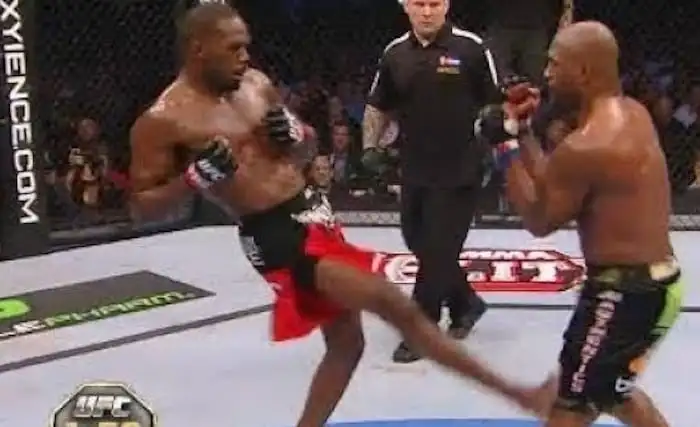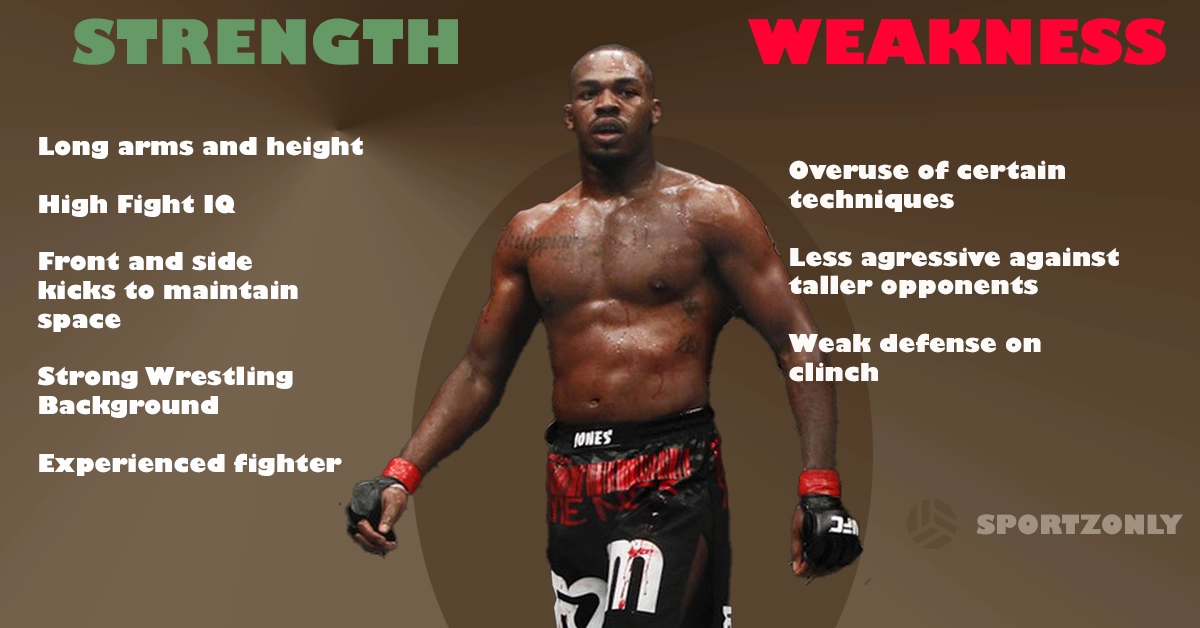Debuting in 2008, Jon Jones has remained undefeated throughout his 16-year career. As the youngest UFC champion with 11 title defenses, he’s widely regarded as the GOAT in the UFC.
What defines Jon Jones fighting style? What is the secret to his success? Which strikes does he favor, and what are his strengths and weaknesses? Let’s explore these questions in this blog post.
Jon Jones Striking Skills
I would explain using very simple sentences so that everyone who reads this can understand.
Jon Jones is great at defense, but here’s the fighting style:
Long Arms & Height: Jon has a huge reach (distance between fingertips) and is taller than most opponents. This lets him keep them away with.
Stiff arms: He uses his long arms like a fence to block punches and kicks.
Jabs: Jabs are quick punches that push opponents back.
Kicks: He uses front and side kicks to maintain space. He was one of the first to use a special kick called an “oblique kick” effectively in MMA.

Footwork: He moves sideways to dodge attacks and isn’t easily cornered. He’s good at using the entire fighting area (the cage) and cutting off his opponent’s escape routes.
Clinch: When opponents get close, he sometimes uses grappling to control them briefly and then restart his attack.
Good at keeping distance: Jon uses his long arms and legs to stay out of his opponent’s reach, making it hard for them to hit him.
High guard: He keeps his arms high to block most punches and head kicks, like a shield.
Head movement: When close to his opponent, he subtly moves his head side-to-side to avoid punches without making himself vulnerable to other attacks.
Shin blocks: He can effectively block leg kicks with his shins, even against strong kickers.
Striking Techniques:
Striking: Jones is a very creative and unpredictable striker. He throws a wide variety of punches, kicks, elbows, and even fakes to keep his opponents guessing.
Spinning moves: Jones is famous for his spinning elbow attack, which he can land even without much setup. He can also throw multiple elbows in a row effectively.
Check out Jon Jones’ signature spinning elbow at 1:44 – 1:50 in the video.
| Strikes landed by Jones on his opponents | ||
| Target | Strikes | percentage |
| Head | 689 | 47% |
| Body | 359 | 24% |
| Leg | 420 | 29% |
Switching stances: Jones can switch between fighting positions (southpaw and orthodox) quickly, which allows him to surprise his opponents with kicks and punches from unexpected angles.
Adaptability: Jones is smart and can adjust his fighting style during a fight. He can switch from striking to grappling depending on what’s working better.
Long Range: He uses his reach well with punches and kicks to control the fight from a distance.
Mid-Range: He’s particularly skilled at using elbows in close quarters, which can be very damaging.
Short Range: When close to his opponent, he throws elbows, uppercuts, and knees effectively.
Areas of improvement in Striking:
Overuse of certain techniques: While his spinning attacks and high kicks are effective, he sometimes relies on them too much, which can become predictable for experienced opponents.
Close Range: While good at staying away, Jones’ defense weakens when opponents get close (called the clinch). This is because:
Uppercuts & Hooks: Punches from below can sneak through his defenses.
Less effective: Dodging and blocking become harder in tight spaces.
Who troubles him most?
Tall & Long Fighters: Opponents with similar reach can bypass his long arms.
Quick & Agile: Fast fighters can get close before he can react.
Good Footwork: Fighters who can move well and find openings around him. For example
Alexander Gustafsson: Had the height, reach, speed, and footwork challenged him in their first meeting but eventually Jon Jones secured victory. Against larger opponents, he might be slightly less aggressive with his attacks.
Dominick Reyes: Speed and footwork caused problems early in the fight.
Lyoto Machida: Excellent footwork allowed him to land punches in the early round of the fight.
Stiff arms against bigger opponents: While his long arms are an advantage when he has space, using stiff arms to block attacks from bigger guys can leave openings.
Vulnerable to low kicks: His wider stance makes it easier for opponents to target his legs with low kicks. This wasn’t a major issue most of the time, but Thiago Santos exploited this weakness.
Jon Jones Wrestling background
In Jon Jones’s 16-year career, he has been taken down only twice in his fights. His strong wrestling background and long reach make it difficult for opponents to take him down. He is also skilled at fighting in close range, using his knees, elbows, and shoulders to maintain distance and balance against opponents, often leveraging the cage to his advantage.
However, Jon Jones sometimes struggles against tall and large opponents in takedown defense, as was evident in his match against Alexander Gustafsson where he was taken down twice.
In terms of ground defense, only two fighters have managed to land significant strikes on Jon Jones throughout his entire career. This occurred during his bouts with Daniel Cormier and Rashad Evans. Against Cormier, Jones utilized movement to evade strikes, while he relied on his long arms to defend against punches from Evans.
Jon Jones Grappling Skills
Many opponents have attempted chokeholds and leg locks against Jon Jones, but these techniques have generally been ineffective. One notable submission attempt came from Vitor Belfort, who applied an armbar against Jones. In response, Jones attempted to pull his arm out, inadvertently worsening the situation by straightening his arm and making it easier for Vitor to apply pressure. Vitor even heard Jones’s arm pop, but he loosened his grip momentarily, mistakenly thinking he had broken it, which allowed Jones to escape.
More Susceptible-Despite Jones’s advantage of long limbs in other aspects of his fighting style, they can also make him more susceptible to being trapped by opponents.
Submission Attempts on Jon Jones | |
| Total Fights | 28 |
| Total Submission Attempts on Jon Jones | 1 |
| Fights lost by Submission | 0 |
However, overall, Jones has demonstrated a keen awareness of submission maneuvers and has rarely found himself in significant danger from them.
When it comes to takedown offense, Jon Jones utilizes Greco-Roman wrestling skills to slam his opponents to the ground.
Over the years, he has become increasingly creative, incorporating different moves such as trips, overhooks, and tackles to bring them down. Jones’s striking skills are diverse, incorporating a mixture of attacks including shoulder strikes and spinning elbows. However, against taller opponents, Jon Jones tends to refrain from takedown attempts and instead focuses more on striking.
Take down Attempts by Jon Jones | |
| Takedowns Attempted | 97 |
| Takedowns landed | 36 |
| Total percentage | 45% |
Next is his ground and pound offense, in which Jones is exceptionally dangerous. His elbows are incredibly powerful, particularly when he’s in a dominant position on top of his opponent. He exhibits remarkable skill in landing these sharp elbows and is adept at throwing punches while controlling his opponents on the ground to maximize his striking opportunities.
Overall, his ground and pound technique is top-notch, and he has finished many fights with it
Jon Jones KOs in the UFC | |
| Total KOs | 5 |
| KOs on the ground | 5 |
| KOs using Elbows | 4 |
Submission Skills of Jon Jones
Jones is really good at getting his opponents into positions where he can apply these guillotine chokes, possibly because of his height advantage. Most of Jon Jones’ submission victories were guillotine chokes. He’s shown some diversity in his submissions, winning fights with a rear-naked choke and an Americana submission as well.
| S.no | Opponents | Submission Method | Event |
| 1 | Ciryl Gane | Guillotine Choke | UFC 285 |
| 2 | Vitor Belfort | Keylock | UFC 152 |
| 3 | Lyoto Machida | Guillotine Choke | UFC 140 |
| 4 | Quinton Jackson | Rear Naked Choke | UFC 135 |
| 5 | Ryan Bader | Guillotine Choke | UFC 126 |
| 6 | Jake O’Brien | Guillotine Choke | UFC 100 |
However, his submission skills are limited and he hasn’t shown much interest in other types of joint locks.
Jon Jones Knockout Power
Power:
Jones has won fights by knockout (KO) or technical knockout (TKO) 10 times, but most happened when his opponent was already on the ground.
He can hurt fighters while standing too, with moves like spinning elbows and high kicks. He’s stunned strong opponents before finishing them with other moves.
However, Jones isn’t known for knocking people out with a single punch or kick, even though he’s one of the biggest fighters in his weight class. This might be even more true when he fights heavier opponents.
Kicks that many consider dangerous haven’t knocked out his opponents, and strikes to the body and legs don’t always have a big effect.
Jones has fought some of the toughest opponents around, who can take a lot of punishment.
He’s very good at causing cuts and bruises, especially with his elbows. Most of his opponents bleed after fighting him. Jones can hurt people, but his main strength isn’t knocking them out with one big hit.
How good is Jon Jones Chin?
Jon Jones is a tough guy. He’s never been knocked out in a fight, which is pretty amazing. Even when he gets hit hard, he doesn’t seem to get hurt too badly. Like, remember when Lyoto Machida landed a big punch on him? Jones didn’t even look fazed.
And in another fight with Gustafsson, he took some hits but kept going strong. There was this one time he got his nose bloodied up in a clinch with Cormier, but he didn’t show any signs of being seriously hurt.
Even when Rashad Evans landed a really clean punch on him, Jones barely reacted. Opponents have tried to hurt him with body shots and leg kicks, but he just keeps on going. It’s like he’s made of steel or something. But, you know, he’s not invincible. Sometimes he gets hit, but he’s really good at rolling with the punches and not taking too much damage.
Overall, Jon Jones has a very good chin and is a tough guy.
Vignesh Subramanian is a true MMA enthusiast — always tuned in to the latest fights, breaking news, and behind-the-scenes updates. If it’s about MMA, he’s already watching it

Leave a Reply